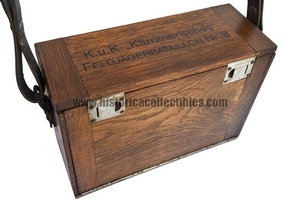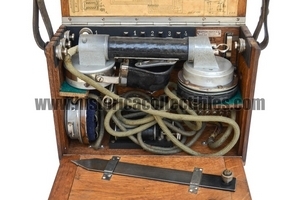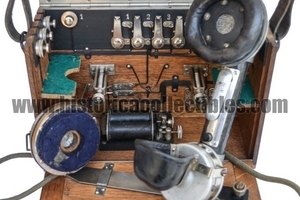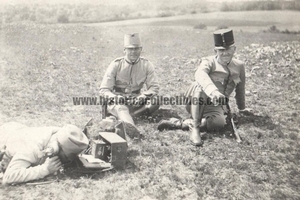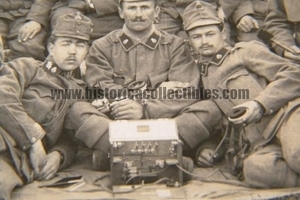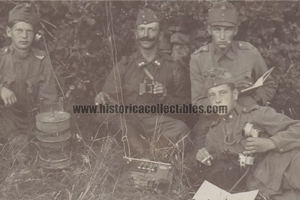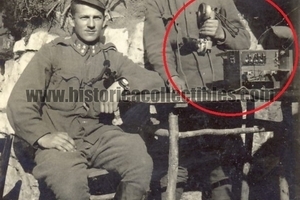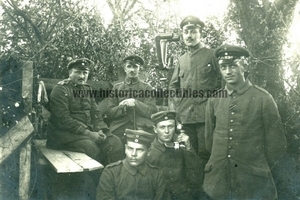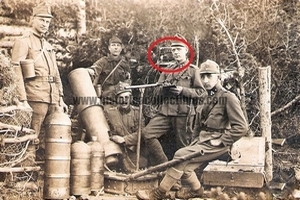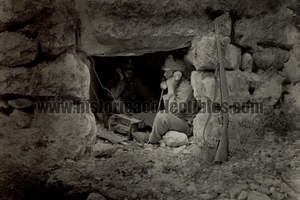Feldtelefon mod. 09 Ericsson K.u.K., Kärntnerisches Feldjägerbataillon Nr. 8, 1915
Feldtelefon or Austrian field telephone mod. 09, produced in 1915, by "Telephon Fabrik A.G." - "vorm. j. Berliner" "WIEN, XIII/2 Missindorfstr. 21".
The speaker plate is marked "ERICSSON OE E.A.G. VORM. DECKERT & HOMOLKA WIEN" and the listener "T.A.G."
There is the Military acceptance stamp adopted for transmission equipment starting from 1917, namely "K.u.K. K.M. 5/T.B. F.S.T.G.".
What makes this apparatus exceptional and historically relevant is the presence on the lid of the writing relating to the department it belongs to, K.u.K. „Kärntnerisches“ Feldjägerbataillon Nr. 8.
Excellent storage conditions: complete with its original shoulder strap.
These are the main events that saw this Battalion involved in the First World War:
26 August 1914 Participates in the Battle of Gologory.
7 September 1914 Participates in the Battle of Grodek.
From 12 December 1914 he participated in the Battle in the Carpathians, involved in the very hard and bloody clashes in Nowy Sacz and Blaszkowa. Towards the end of December 1914 he took part in the Defensive Battles in Gorlice.
In 1915 he found himself fighting in Lomnicatal and at Jawornikhöhe. He was subsequently transferred to the Bessarabian border where he participated in the Battle of Dobronoutz.
In July 1915 he was deployed in the Positional and Defensive Battles on the Dniester in Koscielniki and Sinkow.
On 23 October 1915 he was transferred to the Isonzo Front and took part in the 4th Battle of the Isonzo at Monte San Michele.
On 12 December 1915 he was transferred to the front in Carinthia on Monte Poco Pal.
On 26 October 1917, involved in the 12th battle of the Isonzo, it advanced from Plöckenfront above Stauli, Roner, Paluzza, up to Ravascletto Ovaro in Canzia. He faced heavy fighting with the retreating Italian troops.
On the night of 7/8 November, after heavy assaults, he occupied the Rementerra: from there he launched heavy attacks towards the Italian troops located in the Piave Valley, Longarone valley, Belluno and Feltre.
On 19 December 1917, he carried out an attack on the northern slopes of Monte Grappa.
From 20 January to 11 February 1918 he participated in the Defensive Battles on Monte Pertica.
From the beginning of the 12th Battle of the Isonzo, the battalion, initially made up of 1100 men, suffered numerous losses: 900 deaths on the field.
On 5 November 1918 the retreating battalion was captured by Italian troops in Madonna di Campiglio.
Telephon Fabrik A.G." - "vorm. j. Berliner" "WIEN, XIII/2 Missindorfstr. 21" was founded by Emile Berliner, the man who perfected the Bell telephone and made it a marketable proposition. Berliner saw the Bell telephone in operation and decided to refine it and make it a better and more perfected instrument. He succeeded. and filed his patent on June 4, 1877. It was a "free contact" transmitter. He also invented an "Induction Coil" to be inserted into the circuit to prevent "interruptions" during the call when the contacts separated. Bell came to knowledge of Berliner's patent and purchased the rights to the transmitter for an astronomical sum of $50,000. Bell also asked Berliner to refine their instrument and resolve the problems he encountered.
Thomas Edison filed a patent for a similar transmitter which was also improved in that, thanks to "coal dust", it allowed more contacts compared to Berliner's which only provided one. The two patents were deemed "in conflict" by the Patent Office."
Meanwhile, the American Bell had been offered a new single transmitter by Francis Blake. This had been patented by Blake, and Bell decided to use it. Berliner refined into a production transmitter.
The directors of American Bell decided to delay the application of Berliner's patent to their equipment.
They informed the Patent Office that they needed to take time before responding to their requests.
Their goal was to sustain the patent long enough so that when the patent expired, Blake could activate the Berliner patent and maintain control of the telephone for another seventeen years. Following the resolution of the legal battle with the American Telephone Company, Edison's patent holder, American Bell, controlled all of the important telephony patents. Berliner was frustrated by the inactivity of his first major invention and left the company.
Even though he was now an American citizen, Berliner maintained contact with his family in Germany. In 1883 he demonstrated his single-contact transmitter in Austria. His interest was so strong that he founded a company, the "J. Berliner Telephone Factory (Telephon-Fabrik Berliner AG) in Hanover, Germany, which was managed by his brother Jacob.
The other brother, Joseph, was called back to Germany to become the factory's technical director: he had spent several years studying the telephone in the Bell laboratories and had thus become a competent technician and designer. Jacob became the company's sales manager because he was the only one who had experience running a business
There were international patent recognitions in place in those years: manufacturers such as Siemens and Halske in Germany and Ericssons in Sweden had managed to copy and improve Bell's invention, without patent problems. The Berliner company began producing telephones that conflicted with the Bell company's patents.
In 1893 Emile Berliner patented a transmitter very similar to Edison's model.
The German Post Office supported the local producers of this new industry. The company was able to supply parts and complete phones and set up factories and agencies in Vienna, Budapest, London and Paris. They had to be careful not to sell into the countries where Bell's patents were granted. They had to mark their equipment with the words "Use Not Licensed Under Any U.S. Patents".
The company was renamed Bayerische Telephon-Fabrik AG (BTA) in 1918 or 1920. At that time it was starting to experience financial difficulties. After the First World War the German market was limited due to the developing depression and the post-war punitive measures, and only companies with foreign participation were able to move forward successfully. By 1930 about 72% of the market was controlled by Siemens and Halske, and most of the rest by Elektrizitatgesellschaft (owned by ITT). In 1931 the company was renamed Tefag (Telefono Aktiengesellschaft vorm. J. Berliner).
K.u.K. „Kärntnerisches“ Feldjägerbataillon Nr. 8

